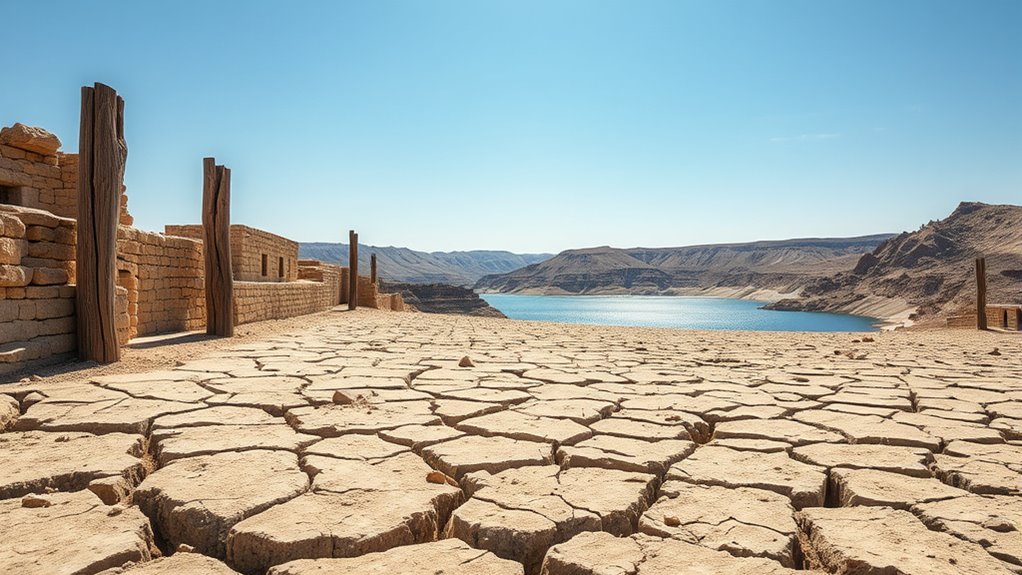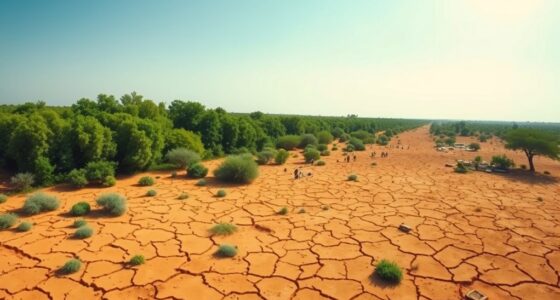A severe drought has uncovered an ancient village long hidden under a reservoir, revealing well-preserved relics and offering new insights into past communities. As water levels drop, you can see structures and artifacts that were once submerged, highlighting how environmental changes shape archaeology. This discovery emphasizes the importance of preservation and responsible management to protect these priceless treasures. Keep exploring to learn more about how researchers are conserving this incredible site and what it tells us about history.
Key Takeaways
- Drought conditions lowered water levels, exposing the ancient village buried beneath the reservoir.
- The submerged site offers valuable archaeological insights into past civilizations and human-environment interactions.
- Preservation efforts are crucial to protect exposed relics from environmental damage and deterioration.
- Responsible excavation and conservation techniques ensure the site’s integrity during uncovering and study.
- The discovery highlights the role of environmental changes in revealing hidden cultural heritage and informs sustainable site management.

As you stand amidst the ruins, you realize that this discovery isn’t just about uncovering the past—it’s about understanding how humans interacted with their environment. The site’s preservation becomes essential, not only for historical research but also for inspiring sustainable practices today. Implementing water-saving measures and responsible excavation techniques become crucial to prevent damage to these priceless relics, which might otherwise be compromised by careless handling. Additionally, adopting archaeological preservation techniques can help protect the site from further deterioration caused by exposure or environmental changes. Recognizing the significance of environmental factors in archaeological conservation highlights the need for careful management during excavation and display. Incorporating mindful decluttering strategies in site management can also improve organizational efficiency and reduce unnecessary disturbances during conservation efforts.
Frequently Asked Questions
What Methods Will Archaeologists Use to Preserve the Site?
You’ll want to contemplate conservation techniques like controlled water management and physical barriers to protect the site from further erosion. Site stabilization is vital; archaeologists often use soil reinforcement and protective coverings to prevent damage. Documenting and monitoring the site regularly helps identify any issues early. These methods guarantee the ancient village remains preserved for future study and public education, maintaining its integrity despite environmental challenges.
Are There Similar Submerged Villages Discovered Elsewhere Globally?
Have you ever wondered if other ancient settlements lie underwater? Yes, across the globe, archaeologists have discovered submerged villages and towns, revealing fascinating insights into ancient life. Many of these sites showcase submerged agriculture, offering clues about past climate and human adaptation. These discoveries help us understand how ancient civilizations thrived and disappeared, highlighting the importance of exploring submerged sites to piece together our collective history.
How Might This Discovery Impact Local Community History?
This discovery can substantially enhance your understanding of local history and cultural heritage. It offers a tangible link to the past, revealing the historical significance of your community’s ancestors. By uncovering this submerged village, you might gain new insights into their way of life, traditions, and resilience. It encourages you to preserve and celebrate your cultural heritage, fostering a deeper connection to your community’s story and the importance of safeguarding these historical sites.
Will the Reservoir’s Water Levels Be Permanently Affected?
Think of the reservoir as a delicate balancing act on a tightrope. Will it stay steady or wobble? You’d likely see the water levels fluctuate with droughts, revealing more of the ancient village. While short-term drops show vulnerability, reservoir stability depends on smart water management. If you focus on sustainable practices, the water levels can be maintained, reducing long-term effects and preserving this precious resource for future generations.
Could Climate Change Influence Future Archaeological Findings?
You might wonder how climate impact influences future archaeological predictions. As climate change causes more extreme weather and droughts, it can reveal hidden archaeological sites like ancient villages previously submerged or buried. These discoveries depend on shifting water levels and environmental conditions. By monitoring climate impact, archaeologists can better predict where to look for submerged or hidden artifacts, making future findings more frequent and insightful.
Conclusion
As the waters recede, you get a rare glimpse of history’s quiet whispers, reminding you that even in times of hardship, nature reveals stories long kept beneath her surface. This gentle unmasking invites you to reflect on the enduring legacy hidden beneath the modern world. Though the village now rests beneath the reservoir, its secrets softly beckon you to imagine the lives once lived there, patiently waiting for moments like this to softly surface once more.









